After not making a big deal out of my having an Oura ring for 1, 2, or 3 years, Oura has presented me with a fancy graphic to celebrate my having tracked my sleep for 4 years.
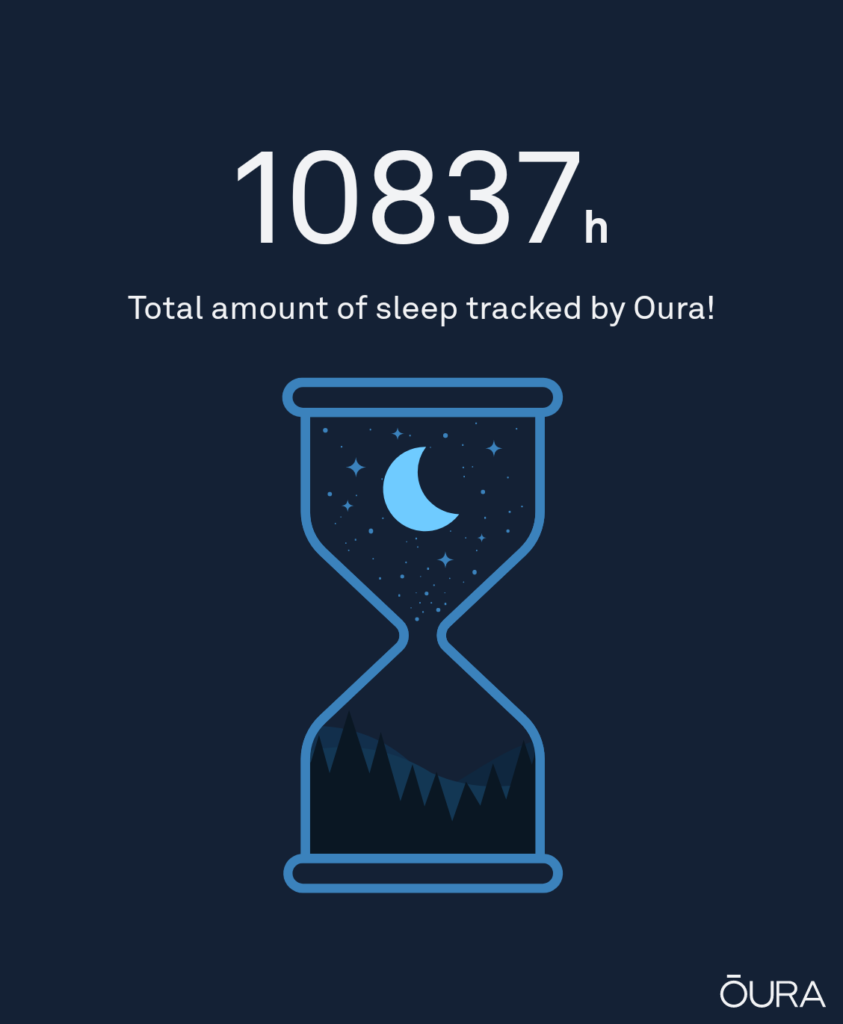

After not making a big deal out of my having an Oura ring for 1, 2, or 3 years, Oura has presented me with a fancy graphic to celebrate my having tracked my sleep for 4 years.

I wrote this a while ago, after seeing two articles in two days ragging on fitness tracking devices, and suggesting that they’re bad for you. Both articles warn against outsourcing your intuitive sense of “how you are” to some device. And, sure, I guess you can do that. But if you actually are doing that, I’d suggest that what you have isn’t a harmful device. What you have is a device disorder.
I was going to make an even stronger statement along these lines, comparing a device disorder to an eating disorder. I think the comparison is valid, even though, upon reflection, it weakens my argument. Sure, some people have an eating disorder. But anybody is likely to engage in disordered eating when they eat industrially produced edible food-like substances. Maybe that’s a fair comparison with industrially produced fitness-tracking devices. Unlike with industrial food though, I think the data from fitness trackers can be consumed safely.
“… sometimes I would wake up in the morning and check my app to see how I slept — instead of just taking a moment to notice that I was still tired…”
Source: Opinion | Even the Best Smartwatch Might Be Bad for Your Brain – The New York Times
I get this, because I joke about this myself. My brother will ask how I slept, and I’ll say, “I’m not sure—I haven’t checked with my Oura ring yet.” Or I’ll say something like, “My ring and I agree that I slept well last night!” But I’m just joking. I know how I slept, I know how recovered I am from the recent days’ activities, and how ready I am to take on a physical or mental challenge.
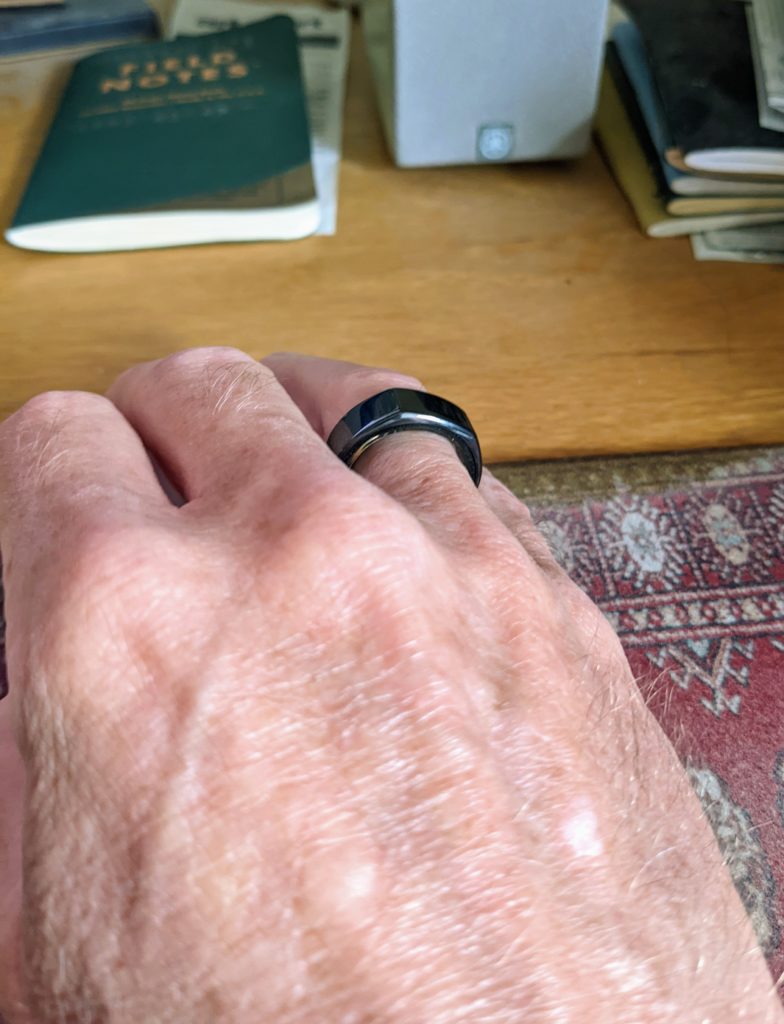
That doesn’t make the data from the Oura ring useless. My intuitive sense of how I am isn’t perfect. Many’s the time I’ve let wishful thinking convince me that I’m ready for a long run or a tough workout not because I really am, but because the weather is especially nice that day and the next few days are forecast to be cold or rainy. Or because I have some free time that day and the next few days are going to be busy. My Oura ring has been a useful counterbalance to that. If I had a hard lifting session yesterday, but I feel great today and my heart rate lowered early last night, maybe I am really ready for a long run today. On the other hand, if my heart rate took the whole night to get down to its minimum, and its minimum was higher than usual, that’s a good sign that I’m not fully recovered, even if I’m feeling pretty good.
If you have an eating disorder, do your best to avoid triggers that lead to disordered eating. Similarly, if you have a device disorder, it makes good sense to avoid using whatever sort of devices lead to disordered behavior. But that doesn’t make the devices bad, any more than eating disorders make food bad. But any particular device might be bad for you, just like any particular food might be bad for you. (And, I admit, industrially produced edible substances are probably bad for everybody.)
A little hiking in the woods gets me a very nice Oura ring activity score. #oura #ouraring
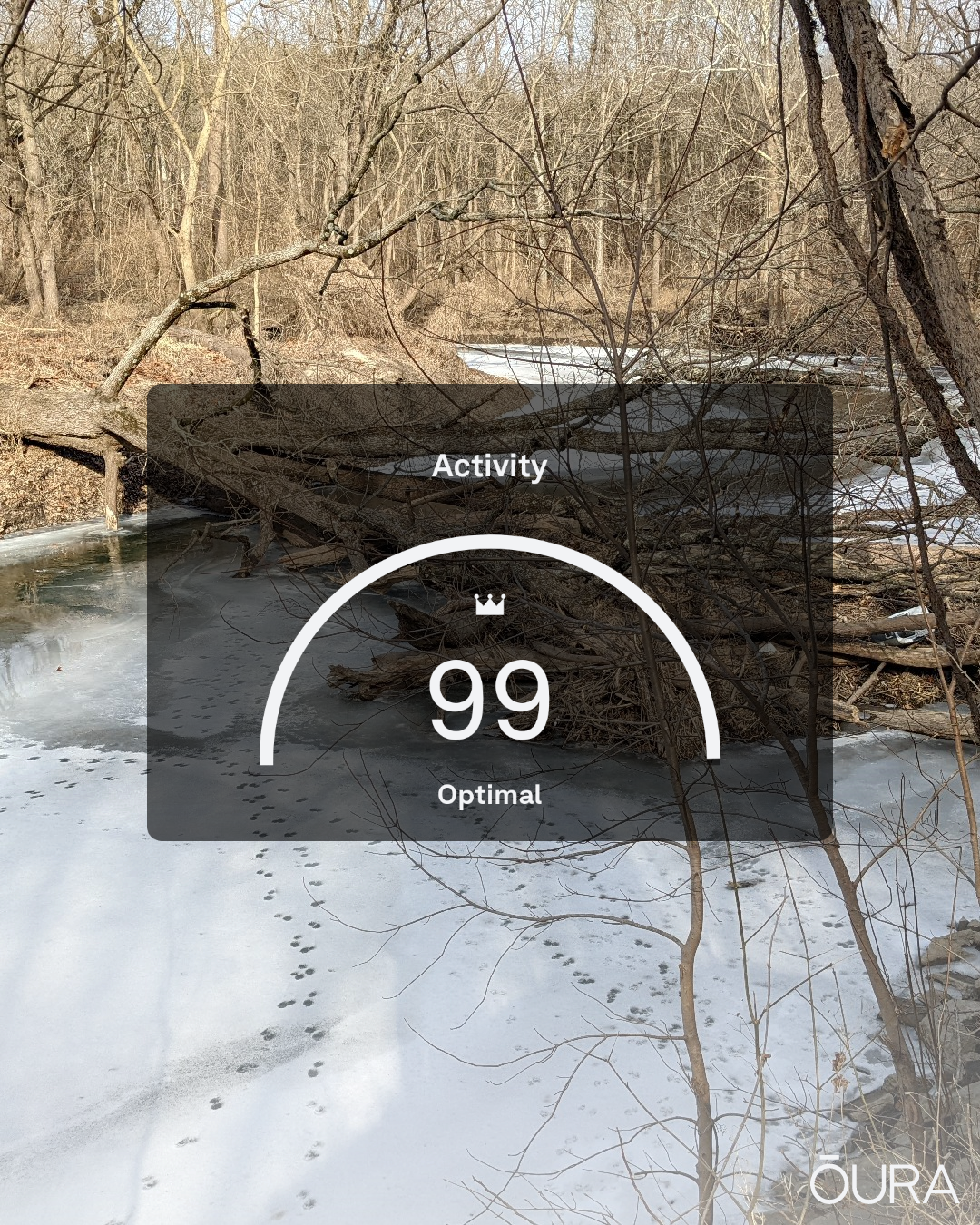
We know hyper-palatable foods are bad for us, and that eating a diet based on minimally processed whole foods—such as a paleo diet—is better. I contend that hyper-comfortable beds are bad for similar reasons, and that the sweet spot for bedding comfort will be a level similar to what a caveman could come up with: a paleo bed.
During a recent run I listened to yet another podcast on the importance of getting enough sleep. (Since a bout of wretched sleep a couple of years ago, this topic has been like catnip to me.) As they almost always do, this one included in its list of tips for improving your sleep, getting “the most comfortable bed you can afford.”
I think this is a terrible idea.
Just so you know where I’m coming from, let me mention that I use an Oura ring, which gives me a “sleep score” every day. After making a few changes (primarily around stress reduction, but also changes to when I eat and a few changes to my sleeping environment), I now sleep pretty darned well. Over the last 3 months my sleep score has averaged 86 (out of 100), on a scale where 85 is the cut-off for “excellent” sleep.
The main reason that I don’t get a better score is due to my “Restfulness” score, which is always low. For example, my last night’s sleep got a score of 92, but my Restfulness was just 76, which as you can see qualifies as “Good.” My average Restfulness score over the past 3 months was 71.
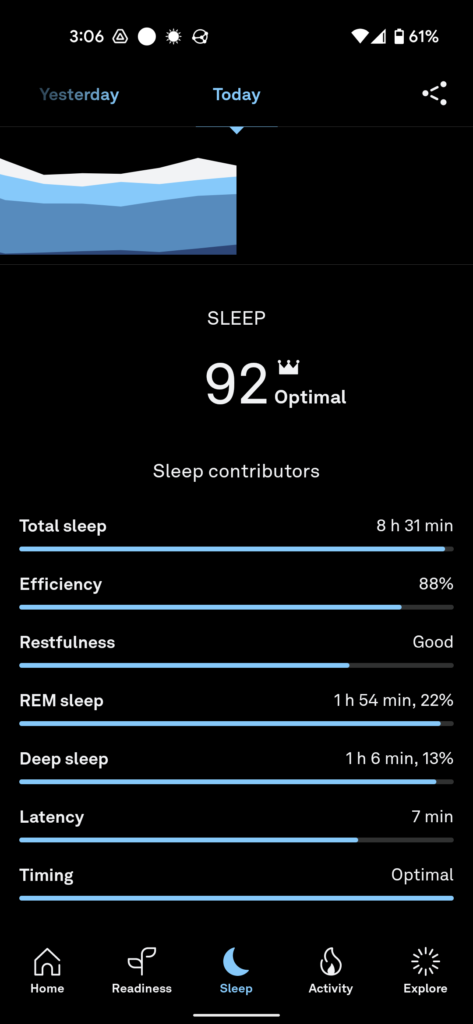
I don’t know exactly what goes into the Restfulness score, but I gather that it is primarily affected by movement. Each time you get up during the night your Restfulness score goes down, but just waking up enough to roll over counts against your Restfulness score (as near as I can tell).
Now, this may be reasonable in a sense: waking up repeatedly during the night almost certainly interferes with the quality of your sleep, and having a more comfortable bed will probably mean that you wake up to roll over less often.
I still think it’s a terrible idea. Spending the whole night lying still is—I strongly suspect, based on no evidence whatsoever—probably just as bad for you as spending your whole workday sitting still.
On a good night I might wake up enough to roll over every 90 minutes or so—that is, after each complete sleep cycle I wake up enough to realize that I’ve been lying still long enough to feel a little uncomfortable, and will roll over to find a new, more comfortable position.
As long as I go right back to sleep every time I roll over, I figure it’s all good. (In the past—when I was suffering from higher levels of stress—I would all too often wake up enough to start worrying about something, and that would keep me from falling right back to sleep, interfering with getting a good night’s sleep. These days I’m doing pretty well.)
Sometimes, such as in fancy hotels, I have slept in very comfortable beds. And it’s true that, lying in a pool of memory foam that conforms perfectly to my body, I often get a very good night’s sleep. But then I wake up achy and sore from having been lying too still for eight hours.
As I see it, the same paleo-lifestyle logic applies to bed as to diet and exercise: We evolved to optimize our overall health sleeping in beds that are as comfortable as whatever our paleolithic ancestors slept on. I don’t know that there’s any evidence as to what that was. I suppose people often slept on the ground. Maybe sometimes in a tree? Presumably they made bedding out of whatever they could find—perhaps a bearskin rug, if they happened to kill a bear and didn’t need the hide for something more important than bedding.
Here’s a proposition for you: If you’re sleeping in something that’s more comfortable than you could improvise out of stuff you could find in nature, you’re making the exact same mistake as people eating hyper-palatable industrially produced food-like substances.
Reject the advice to sleep in the most comfortable bed you can afford! Choose a bed that’s about as comfortable as a paleo bed!
I was sick several days this past week or so. Or maybe it was just a delayed reaction to my booster shot. There’s no way to know.
I got my Covid booster on Thursday last week, and my initial reaction was pretty minor—the injection site was mildly sore for about three days.
On Monday this week I met with my Esperanto group as usual, and went with Jackie to her x-ray, post-surgical consult, and physical therapy appointments on Tuesday, also as usual. I’d felt fine in the morning, and we’d made a plan to go out to lunch, but by the end of the physical therapy appointment I was starting to feel crappy, and said I wasn’t up to lunch out.
That night I spiked a fever of 100.2℉, and had the usual body aches that go with a fever.
I didn’t start coughing, so I figured it probably wasn’t Covid, but out of courtesy to my fellow Esperanto group members, I sent email the next morning letting them know about my fever.
I felt some better most of the day on Wednesday, but then felt much worse Wednesday evening.
That night my fever spiked up to 102.9℉. Still no cough though. In fact, no other symptoms—no sore throat, no stuffy nose, no nausea. Just a fever.
With that high of a fever, I figured I should probably get a Covid test, so I did that Thursday morning, and otherwise just rested.
My Covid test came back negative, which was reassuring, but still left me wondering what the heck it was.
I woke up Friday morning feeling almost entirely well. My Oura ring reported that I still had a upward overnight temperature deviation, but my implied fever was just 99.8℉.
I’d planned a day trip with friends on Friday, but figured I had to cancel that. I spent another day just resting, although I basically felt fine.
Today I again feel fine. My overnight temperature is back down to baseline.
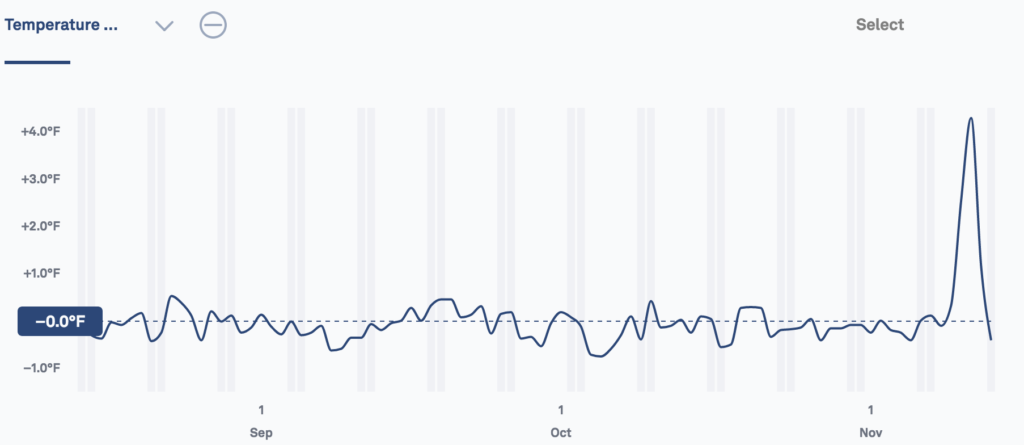
I have to say that I’m pretty pleased to have this temperature data from my Oura ring. It has been very handy. Looking back over three years of data, I can see one other temperature spike almost this large, from another day when I was sick, and smaller temperature spikes when I’ve had vaccines of one type or another (two shingles, three flu vaccines, and my two previous Covid shots).
As I say, I’m feeling fine today, but one other metric that I pay attention to is not yet back to baseline: My resting heart rate.
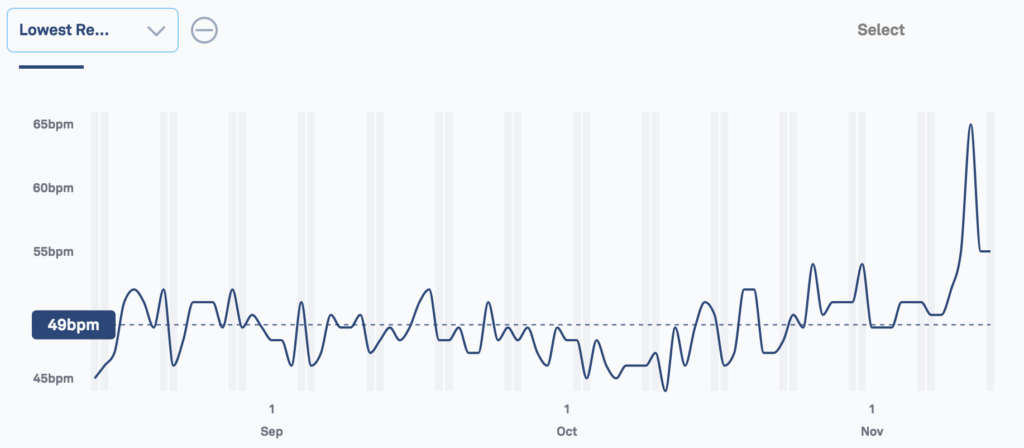
My resting heart rate has done a very good job of indicated whether I’m ready for vigorous activity, and the current level suggests that I’m really not.
So I’ll take it easy again today. Do my morning exercises. Maybe get in a little walk.
I’ve documented all this primarily as a record for myself, so I can look back and remember what happened on which days. I’m still in the dark about what was going on, though. Presumably not Covid, based on the negative test. Maybe the flu? (I got my flu shot in early October, but it’s not nearly as efficacious as the Covid shot, so catching the flu and feeling crappy for a few days is entirely possible.) Maybe some other virus?
Or maybe it’s just an unusually delayed reaction to my Covid booster.
I guess I’ll have to live with the question.
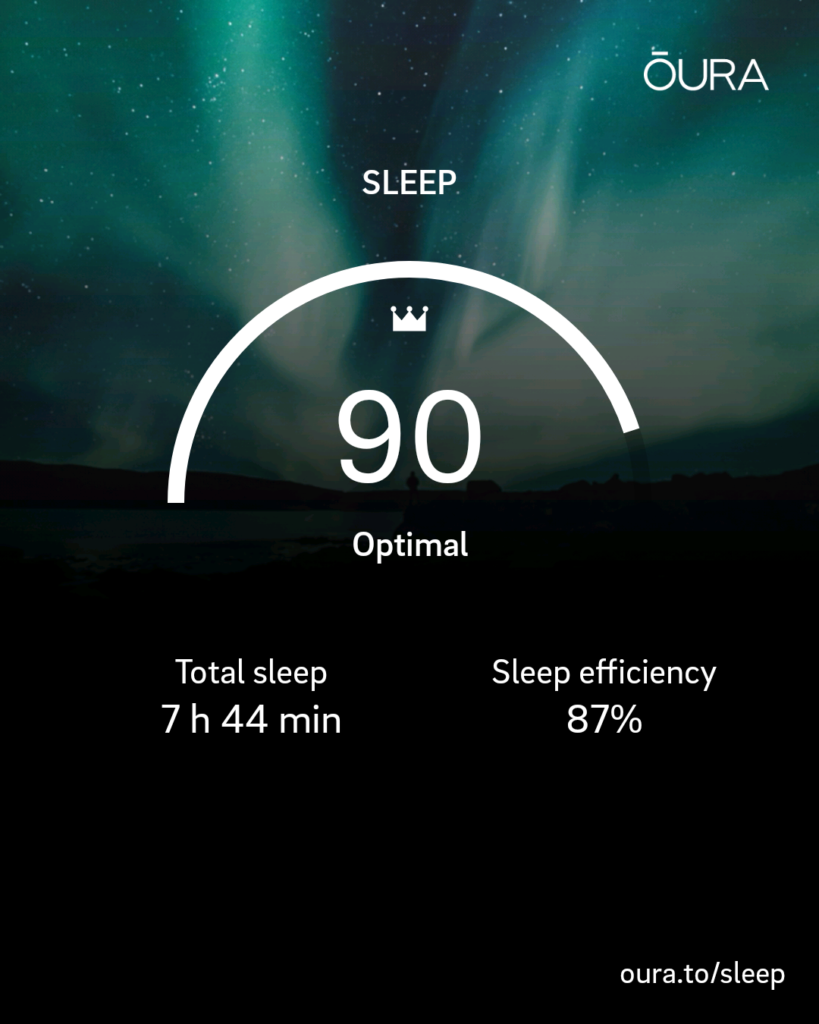
After a couple of nights of poor sleep mid-week due to stress, I’ve now had a couple of nights of good sleep, including last night.

For some time now I’ve been aiming to do my endurance training at my MAF heart rate. MAF stands for Maximum Aerobic Function, and it’s the heart rate where you’re producing the maximum output without having to use anaerobic systems. Although the MAF formula just produces an estimate, there’s quite a bit of data to back it up.
If you do almost all your training at MAF, you’ll get better (run faster) at that heart rate. The idea is that you first do that, and only when your performance plateaus do you need to start doing any sort of speed work (and then not much of it).
As I say, for some time I’ve been aiming to train at my MAF heart rate, but it’s a low enough level of intensity that I’ve persistently had trouble not running too fast. I have a heart rate monitor, but it’s not very useful during a run, because my heart rate is displayed on my phone, and I don’t want to run around carrying my phone where I can see the screen. The upshot has been that I’ve inadvertently done a great deal of my training somewhat above my MAF heart rate, which rather defeats the purpose.
To get a better grip on my MAF training, I finally broke down and bought another heart rate monitor, which displays my heart rate on my wrist so I can check it while I’m running. It also has an alert function, so I can set it to vibrate if my heart rate goes above some value. After looking around a bit, I settled on the Mi Band 4 (which is available for cheap because the Mi Band 5 is now out). It does the thing I want well enough. (It also does a bunch of other stuff that I don’t care about, and some things that I do care about (sleep tracking), but that I do some other way, such as with my Oura ring.)
After a shakedown run a few days ago, where I spent a lot of time trying to figure out how to use the device the way I wanted, today I went out for a run where I tried to use it for some proper MAF training, and I think I was very successful. I probably only spent two or three minutes (out of a 51-minute run) with my heart rate above my target.
This very easy run was nice and gentle. Sitting here at my computer maybe an hour after I got home, my heart rate is already back down to just 64 bpm, which amounts to a surprisingly complete recover. After a run only a little bit faster, I’d expect to see my heart rate stuck in the 70s for several hours.
Now to see if regular training this way produces the speed gains it is reputed to.

I did an experiment a couple of days ago: I tested a combined workout that doubled up two pairs of exercises that I’d been doing separately. Up to now I’ve been doing four sessions each week: two where I do pull ups & pushups, and then two where I do dips & inverted rows. (Together with a leg exercise and a core exercise each workout.)
That was working very well, but it meant 4 upper-body strength sessions each week, which is a lot. Throw in a couple of lower-body strength sessions as well (such as hill sprints or kettlebell swings), plus a rest day, and I didn’t have a day to do anything else. This sort of volume has been well for me so far, but I think I may have reached a limit, and would benefit from a cycle of deeper recovery than just a week of lighter workouts: Except for “de-load” weeks in mid-March and mid-June, I’ve been averaging close to 5 workouts a week since the end of January. I’m thinking I want to take it down a notch.
With that in mind, I’ve been thinking about how I want to structure my training through the fall and winter. One obvious change was to go from four days of upper-body strength training per week to just three. The problem was that I didn’t see an easy way to evenly cover the range of pushing and pulling exercises at a reasonable volume with just three workouts a week, except by doing both pairs in each workout.
Hence my experiment, in which I did just that.
It was not a complete success. I managed to crank my way through the workout, but it was very long and tough. I don’t think I could keep it up three times a week for months.
Happily, while describing my difficulties to my friend Chuck, I had a brainstorm: I could do threes workouts per week—two of them just like what I’ve been doing (one with pull-ups & push-ups, and then another with inverted rows & dips), and then do just one combined workout. That keeps my workouts even, as far as covering all four exercises twice each week, without being quite so overwhelming as trying to do the combined workout three times a week.
With just three upper-body strength workouts per week, I have four days for other stuff, and I can mix and match as I choose. I can do the hill sprints that Anthony Arvanitakis recommends, or I can do kettlebell swings. (Either of those makes a good HIIT workout.) I can go for a run. I can go for a hike. I can do my animal moves. In particular, I can do two rest days, if that seems like a good idea. (Which I think it probably does. At least my Oura ring thinks so.)
This all got started back in February, when I figured out that I was lacking in consistency. (Previously I’d imagined that the problem was a lack of intensity.) Targeting 5 workouts a week has meant that, even when I miss one, I get in more than when I was targeting 3 workouts a week—even if I didn‘t miss one.
I don’t want to give up the consistency, I just want to take the volume down a notch. Hence the struggle. But I think now I’ve got a plan.
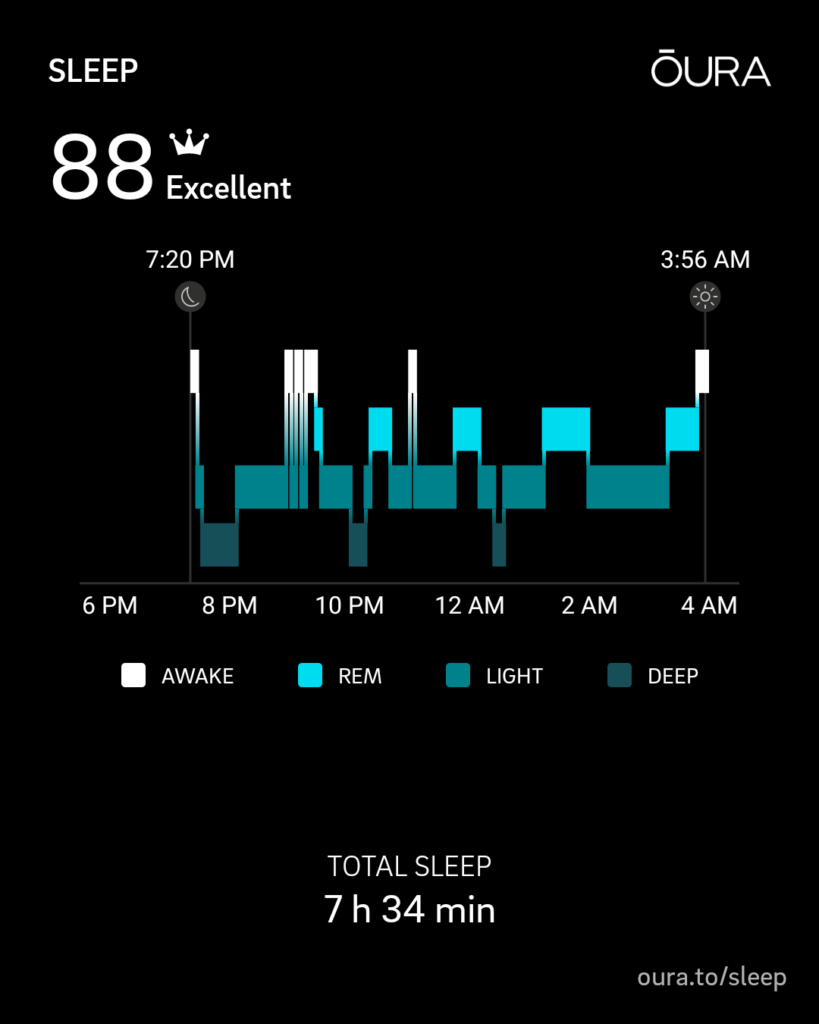
After sleeping poorly the previous night (stress), and being sleepy all afternoon, I went to bed really early last night and got in a excellent night’s sleep, including 56 minutes of deep sleep—well above average for me.
Jackie was fixing blue-corn pancakes with maple syrup for breakfast, and eating that many carbs first thing in the morning can be a problem for me. However, I have come up with a strategy for dealing with it: Getting in a pre-breakfast fasted workout. My theory is that by doing this I deplete my muscle glycogen, so that my muscles are primed to soak up all the carbs I eat, minimizing the degree to which the glucose spikes my blood sugar.
I have no data to show that this works, but anecdotally I can report that it seems to help.
I’ve been wanting to go for a run. I had planned to go for a run yesterday, but it ended up being rainy enough that I decided to postpone the run for a day. So I might have gone for a run for my pre-breakfast workout, but Jackie was hungry early, and I didn’t want to delay breakfast by an extra hour.
So, I did what’s becoming my standard HIIT workout: I warm up with 3×25 Hindu squats, and then I do 3×25 kettlebell swings with my 53 lb kettlebell. It’s a quick workout—it’s all done in 20 minutes, including some amount of pre-workout warmup—and it’s of high enough intensity to burn off plenty of glucose.
After breakfast (and a bit of digesting) I went ahead and got out for my planned run. After the persistently sore foot I’ve been dealing with for months now simply refused to get better, I had taken a full month off from running to see if all I needed was plenty of rest to fully recover, and that may have done the trick—I went out for a 3.33-mile run, and I had no foot pain whatsoever.
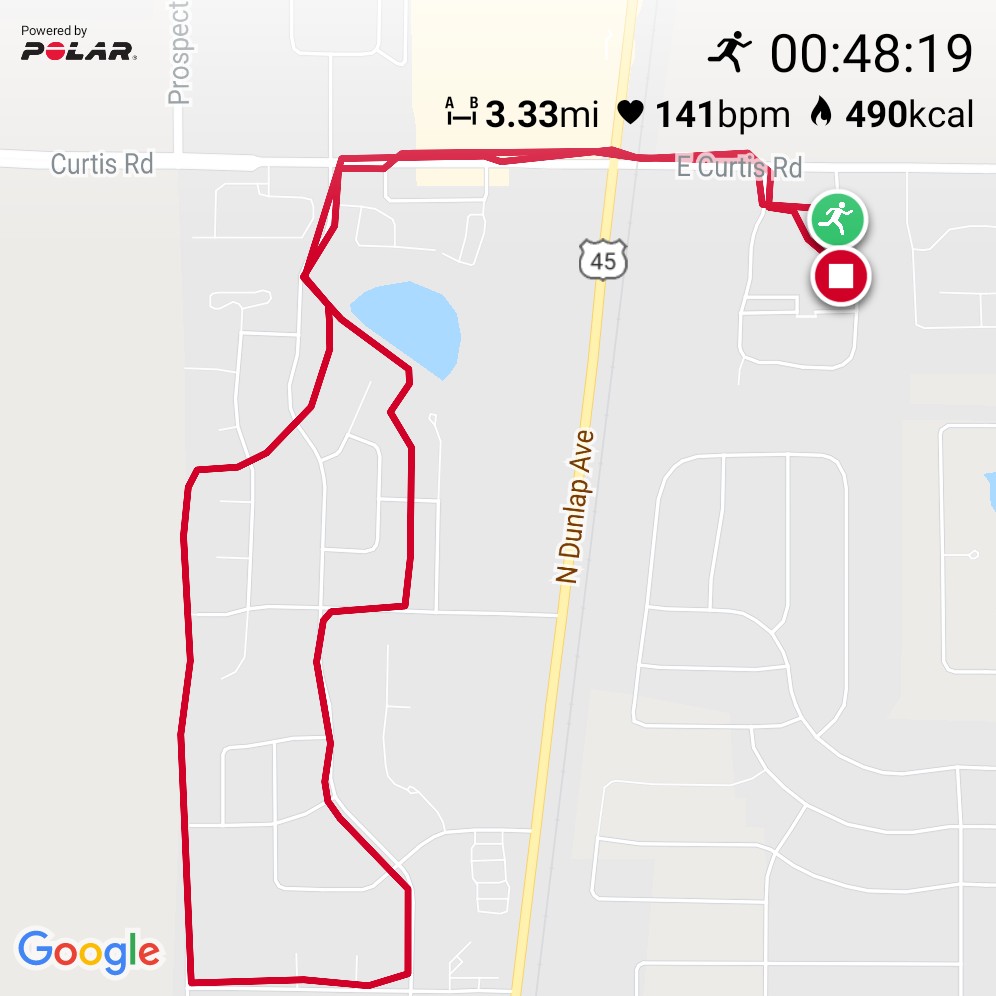
I don’t wear my Oura ring for the kettlebell workouts (or other workouts where I have to grip something, because handles, bars, and (gymnastic) rings don’t play well with the Oura ring). However, my Polar heart rate monitor will tell Google Fit about my workout, and the phone app for the Oura ring will read that data and give me credit for what I did while the ring was off:
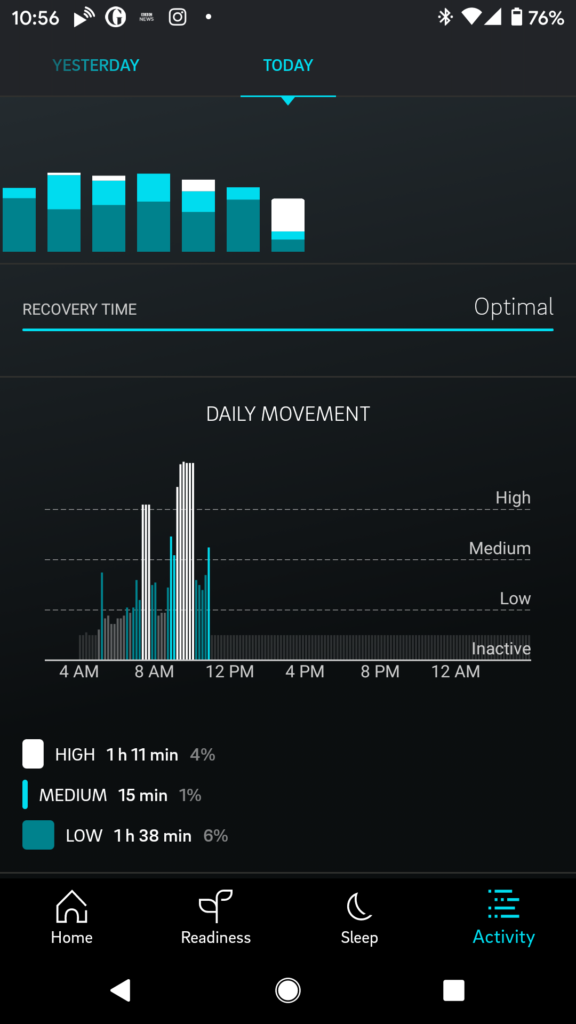
My peak heart rate during the kettlebell swings would have seen me to much higher activity levels than the just-barely “High” levels shown, but that’s because it’s an interval workout. A set of 25 swings takes me just about 50 seconds, and then it takes about 3 minutes for my HR to drop low enough that I can do another set. The software is averaging those periods together. Unless I’m doing sprints (which I didn’t today) a run is just a steady-state effort. I try to keep my HR down in the MAF range, but didn’t manage it today (because of the prior HIIT workout).